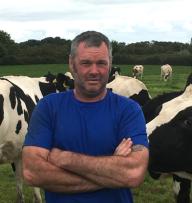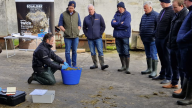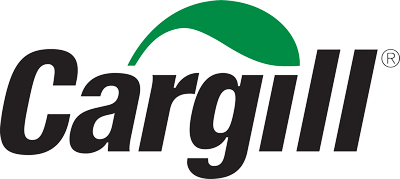- VIEW ALL ARTICLES
- Dublin-Based Dairy Unit Steps Up To Tackle Methane-Reducing Responsibilities
Dublin-Based Dairy Unit Steps Up To Tackle Methane-Reducing Responsibilities
With John Grehan, Dairy Farmer, Dublin
The methane-reducing feed product SilvAir®, developed by Cargill, is part of the tool kit on one Ireland-based dairy unit. Working with the company, and with his feed supplier, dairy farmer John Grehan has integrated the product into his herd’s diet. John is committed to reducing his dairy herd’s methane emissions as part of the drive towards net zero on the family’s farm, which is based at Ashbourne, near Dublin.
Methane is the most significant greenhouse gas produced on ruminant livestock farms, typically forming 50% of total emissions. “We know it’s coming – we’re all going to have to reduce our carbon footprint and this, for dairy farmers, will mean reducing methane emissions,” says John, who runs the 120-cow pedigree Holstein herd with his father, also called John.
The Grehans have spring- and autumn-calving blocks of cows, originating from two consignments of in-calf Holstein heifers bought from Holland in 2003 to replace their original herd, which was taken out by bovine TB more than two decades ago.
John is keen to keep improving the herd, as well as the efficiency and sustainability of the business. And he sees that new, proven technology is key to this, as long as it makes economic sense. Many measures to improve herd efficiency will also support a reduction in the dairy unit’s carbon footprint, so there are gains to be made all round by managing the business in a more sustainable way.
John has made several changes to support this. One is the adoption of genomic testing of his dairy youngstock. He works with his CRV breeding adviser on a genomic-testing programme and uses the data to plan matings. Only those making the cut – predominantly heifers and the best cows – are selected to breed replacements using sexed semen.

“We look to produce just under 40 heifers a year,” he adds. “Using genomic testing means we’re able to accelerate genetic progress, breed a more uniform herd of cows, and improve key traits that support longevity, as well as improved milk yields and solids.” The herd is currently averaging 8,500kg of milk, at 4.78% fat and 3.64% protein. John continues to focus his breeding and feeding management on more efficient production of yields and milk solids to supply to his buyer Tirlán. Genetics are supported by a TMR fed all year round comprising of grass silage, some bought-in maize silage, distillers’ grains, and straw. It is soaked overnight to provide a well-mixed, short chop length and palatable semi-compact diet to encourage intakes.
Cows are fed the TMR indoors for a few hours pre milking and immediately post milking during the grazing season. An 18% pelleted parlour feed is fed in the parlour at a rate of between 2kg and 3kg per head, depending on days in milk. The TMR includes a blend made by feed company McAuleys, and since November 2022, it has included Cargill’s methane-reducing feed product SilvAir®. “I saw an article about SilvAir® and contacted the company’s ruminant technical adviser Philip Ingram. He visited us and we talked about the advantages.
“Knowing that we have to tackle methane has been on my mind for a few years, and I can see it becoming mandatory down the line. The sooner we ‘get on board’ the better, so I took the plunge and asked McAuleys to formulate our blend with SilvAir®. Taking account of the relatively low level of blend being fed, Dr Ingram recommended a 1% inclusion rate.” John noticed a few small ‘wavy’ fluctuations in fat and protein percentages for a week after SilvAir® was added, but then they came back to normal. “Milk urea also went up for a couple of days and then stabilised, but these were all minor and nothing unusual after tweaking a diet,” he says. “Cows were producing the same amount of milk, and feeding, chewing cud and manure were all unchanged. “And after a few weeks we saw a slight 0.02% protein increase.”
Cows strip graze the grass paddocks with a fresh bite every 12 hours. To improve the feed value and duration of the grass John is now including more clover in the mixture. “This has improved growth through the season and the drought tolerance of the swards. It’s also reduced our reliance on artificial fertilisers.” While John is taking a proactive approach to reducing his carbon footprint, he remains a bit ‘baffled’ as to why there’s not more ‘talk’ about it – certainly in Ireland. Particularly as the measures he’s taking - and that others could follow - have been shown to improve herd efficiency.
He feels that Ireland and the UK are behind other European countries in incentivising dairy farmers to reduce their carbon footprint. “I can’t understand what’s holding them, and therefore farmers, back. “I think the industry here in Ireland is too focused on producing cheap milk and not enough on the methane issue. We’re behind other major dairy producing countries. “Some milk buyers and governments are supporting the use of dietary methane reducing feed products and this would certainly drive things forward. Consumer pressure would help too.
“We’ve all got to do our bit to reduce the methane production per litre or kilogramme of milk solids and reduce our carbon footprint by following a clear road map,” he adds. Methane-reducing feed products are becoming more available and more effective so are playing a valuable part in promoting sustainable milk production. Genetics and herd management practices will also be important components. Alongside helping the dairy industry to achieve the environmental targets set out, these improvements are also recognised in supporting more efficient milk production.
SilvAir® - a key tool in Cargill’s methane reducing platform Reach4Reduction
Cargill’s methane reducing product SilvAir® is proven to reduce the emissions of this greenhouse gas in dairy cows. This feed product is a carefully manufactured feed grade calcium nitrate comprising 76% nitrate and 22.5% calcium, with a dry matter of 84%.
SilvAir® is authorised for use in animal feed under EU regulations and in the UK. It must be used in compound feeds at the recommended inclusion rates, which are based on scientific research. Diets where it is included must be reformulated to ensure correct amounts of crude protein are supplied and excess levels are avoided.
It works by ‘mopping up’ some of the hydrogen produced in the rumen during fermentation of feedstuffs. This hydrogen would otherwise combine with carbon to produce methane. But if it combines with calcium nitrate supplied in the diet then ammonia is produced. This ammonia can then be used in the milk production pathway.
SilvAir® results in the production of ammonia in the rumen just as dietary protein does, so its inclusion can mean that dietary protein is reduced. This further supports its role in sustainable milk production.
Trials have shown that 100g of SilvAir® can replace 40g of feed grade urea or 250g of soyabean meal in dairy diets. Also, 100g of the feed product can replace 60g of limestone in cow diets. It is safe to use and stable in compound feeds at these rates and has been shown to have no adverse effects on intakes.
The development of the product is supported by 26 peerreviewed papers in scientific journals, and Cargill now holds the worldwide patent on the use of dietary nitrate in methane reduction from ruminants.
Results from the meta-analysis of all peer-reviewed papers are consistent and show that, where SilvAir® has been included at a rate of 1.6% of the total diet dry matter in dairy diets, it can deliver a reduction in methane emissions of up to 10%, with no negative impact on performance. This can result in a reduction of approximately 1kg of CO2 equivalent per cow per day.
In Belgium, SilvAir® is included on the Belgium Feed Association’s list of technologies to reduce methane emissions and is, therefore, eligible for a government subsidy. In the Netherlands, Friesland Campina has introduced an incentive system to reduce carbon footprint and SilvAir® is included in the toolbox of available solutions.
Here in the UK and Ireland, Cargill is making inroads into the inclusion of SilvAir® in recommended products in carbon auditing bodies. It is included in the online carbon footprint calculator Cool Farm® Tool’s product listings and Agrecalc and can, therefore, be used to adjust the on-farm carbon footprint through reduced methane output.
Cargill’s Philip Ingram estimates diets reformulated to include SilvAir® may have some or all costs offset by reducing other protein previously in the ration.
SilvAir® is part of Cargill’s holistic approach to methane-emission reduction, called Reach4Reduction, which covers three critical areas of impact:
- On-farm productivity management to improve feed conversion rates
- Feed and nutrition to optimise animal performance and health and innovation
- Technologies that reduce methane emissions.
Each of these areas play an important role in determining actionable steps towards reducing an individual farm’s methane intensity while enhancing its productivity and efficiency.

Want to find out more?
Our team is at your disposal for information and questions. Together, we will find the best solution for your business.

